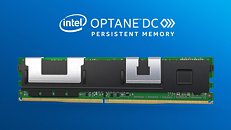Monday, April 8th 2019

Intel Optane Persistent Memory 512GB Module Can be Yours for $7816
Optane Persistent Memory is being touted by Intel as the "hottest" storage medium between DRAM and NVMe SSDs in the short-term, and a successor to DRAM-based memory in the long-term, aided by its ability to hold data even in the absence of power. The company's latest Xeon Scalable "Cascade Lake" processors support Optane Persistent Memory, allowing data-centers to cram larger amounts of data accessible at DRAM-like speeds, even if at much higher latencies. It remains significantly faster than NVMe SSDs. Component retails began listing 512 GB modules of the Optane Persistent Memory, and its prices are nothing like your 512 GB NVMe SSD. CompSource lists the 512 GB module (model: NMA1XXD512GPSU4) for a whopping USD $7,816, although the product is out of stock.


33 Comments on Intel Optane Persistent Memory 512GB Module Can be Yours for $7816
128GB - $577
256GB - $2,125
512GB - $6,751Yes. You cannot drop this directly into any normal DDR4 slot though, it needs support from motherboard and CPU which today is limited to Enterprise.Optane DIMMs are slower than DRAM but they are also much cheaper for the same amount. Persistence is the second part of what Optane DIMMs are about. There are a number or use cases where either of these is very-very useful. Whether this technology makes it to desktop we will have to see in the future.
www.tomshardware.com/news/intel-optane-dimm-pricing-performance,39007.html
This type of technology has to start from somewhere, and while being delayed, its nice to know that its here. Optane has some very unique characteristics that can't be found in other products of the NAND world. Could be interesting for workstations in the future once the tech becomes a little more available and affordable
128GB in one slot as opposed to 8 slots is a big difference.
DDR5 is well on it's way and sooner or later this is will be left in the dust on all fronts, it's evident to me this technology is bound to remain in a awkward middle ground of price/performance/capacity.
But I am still curios to see that list of numerous use cases this has.
8x64GB DDR4 is $3k+: www.newegg.com/Product/ProductList.aspx?Submit=ENE&IsNodeId=1&N=100007952%20601318765
These Optane DIMMs can give you the same capacity in one memory slot, leaving room for expansion.
You would have to choose here, split in many computers or a single computer/mainframe. While a single mainframe is a lot lot lot better overall, is bloody expensive, from a cost benefit, I would split in many computers.
Big Data. Databases. Server farms, including virtualization. Anything that requires heaps and heaps of memory.
Intel has has two access modes to these where Optane-aware application can access DRAM and XPoint parts separately and build application around that.
Some of possible benefits will need software support but the increased capacity is a definite selling point from get-go.
It will win in circumstances where classical memory hierarchy runs out of faster memory. Thus, bigger density is its primary selling point.
Technically it will benefit from XPoint in Optane being in between DRAM and SSD (fast ones, like enterprise NVMe drives) in terms of speed and especially latency.